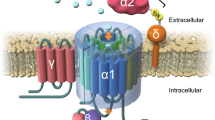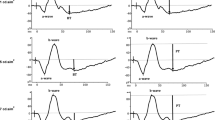Abstract
Purpose
Cannabis is a psychotomimetic agent that induces impairment of sensory perception. We present detailed clinical and electrophysiological data of patients with hallucinogen persisting perception disorder (HPPD) after marijuana consumption.
Methods
A HPPD patient and four heavy cannabis smokers with no visual disturbances (controls) underwent complete ophthalmological examination including psychophysical tests (visual acuity, color vision, visual field, and dark adaptation) and detailed electrophysiological examinations, including extended Ganzfeld ERG, multifocal ERG, and electrooculography (EOG). Furthermore, electrically evoked phosphene thresholds (EPTs) were measured to further evaluate retinal function.
Results
Ophthalmological and most electrophysiological examinations were within normal limits for the HPPD patient and for all control subjects. Interestingly, EOG results of the HPPD patient showed a slightly reduced fast oscillation ratio, diminished standing potentials of the slow oscillations, and a light peak within normal range resulting in higher Arden ratios. The EPTs of the patient were reduced, in particular for pulses with long durations (50 ms) causing visual sensations even at lowest possible currents of the neurostimulator. The control subjects did not reveal such alterations.
Conclusions
Our findings suggest a direct effect of cannabinoids on the retina and retinal pigment epithelium function, which may be involved in disturbances of the visual function experienced after drug consumption. The observations presented here may contribute to the elucidation of the detailed mechanism. Furthermore, EOG and EPT measurements may be useful tools to demonstrate long-term retinal alterations in cannabis-induced HPPD in patients.



Similar content being viewed by others
References
Krill AE, Wieland AM, Ostfeld AM (1960) The effect of two hallucinogenic agents on human retinal function. Arch Ophthalmol 64:724–733
Sharma S, Moskowitz H (1972) Effect of marihuana on the visual autokinetic phenomenon. Percept Mot Skills 35:891–894
Dawson WW, Jimenez-Antillon CF, Perez JM, Zeskind JA (1977) Marijuana and vision–after ten years’ use in Costa Rica. Invest Ophthalmol Vis Sci 16:689–699
Levi L, Miller NR (1990) Visual illusions associated with previous drug abuse. J Clin Neuroophthalmol 10:103–110
Laffi GL, Safran AB (1993) Persistent visual changes following hashish consumption. Br J Ophthalmol 77:601–602
Gaillard MC, Borruat FX (2003) Persisting visual hallucinations and illusions in previously drug-addicted patients. Klin Monatsbl Augenheilkd 220:176–178
Pomeranz HD, Lessell S (2000) Palinopsia and polyopia in the absence of drugs or cerebral disease. Neurology 54:855–859
Baggott MJ, Erowid E, Erowid F, Roberston LC (2006). Prevalence of chronic flashbacks in hallucinogen users: a web-based questionnaire. CPDD annual meeting abstract 45. http://www.cpdd.vcu.edu/Pages/Meetings/Meetings_PDFs/2006abstractbook.pdf
Ffytche DH, Howard RJ (1999) The perceptual consequences of visual loss: ‘positive’ pathologies of vision. Brain 122(Pt 7):1247–1260
Norton JW, Corbett JJ (2000) Visual perceptual abnormalities: hallucinations and illusions. Semin Neurol 20:111–121
Lerner AG, Shufman E, Kodesh A, Kretzmer G, Sigal M (2002) LSD-induced hallucinogen persisting perception disorder with depressive features treated with reboxetine: case report. Isr J Psychiatry Relat Sci 39:100–103
Halpern JH, Pope HG Jr (2003) Hallucinogen persisting perception disorder: What do we know after 50 years? Drug Alcohol Depend 69:109–119
Grotenhermen F (2007) The toxicology of cannabis and cannabis prohibition. Chem Biodivers 4:1744–1769
Sunness JS (2004) Persistent afterimages (palinopsia) and photophobia in a patient with a history of LSD use. Retina 24:805
Sim-Selley LJ (2003) Regulation of cannabinoid CB1 receptors in the central nervous system by chronic cannabinoids. Crit Rev Neurobiol 15:91–119
Svizenska I, Dubovy P, Sulcova A (2008) Cannabinoid receptors 1 and 2 (CB1 and CB2), their distribution, ligands and functional involvement in nervous system structures—a short review. Pharmacol Biochem Behav 90:501–511
Straiker A, Stella N, Piomelli D, Mackie K, Karten HJ, Maguire G (1999) Cannabinoid CB1 receptors and ligands in vertebrate retina: localization and function of an endogenous signaling system. Proc Natl Acad Sci USA 96:14565–14570
Straiker AJ, Maguire G, Mackie K, Lindsey J (1999) Localization of cannabinoid CB1 receptors in the human anterior eye and retina. Invest Ophthalmol Vis Sci 40:2442–2448
Fan SF, Yazulla S (2003) Biphasic modulation of voltage-dependent currents of retinal cones by cannabinoid CB1 receptor agonist WIN 55212-2. Vis Neurosci 20:177–188
Straiker A, Sullivan JM (2003) Cannabinoid receptor activation differentially modulates ion channels in photoreceptors of the tiger salamander. J Neurophysiol 89:2647–2654
Fan SF, Yazulla S (2005) Reciprocal inhibition of voltage-gated potassium currents (I K(V)) by activation of cannabinoid CB1 and dopamine D1 receptors in ON bipolar cells of goldfish retina. Vis Neurosci 22:55–63
Lalonde MR, Jollimore CA, Stevens K, Barnes S, Kelly ME (2006) Cannabinoid receptor-mediated inhibition of calcium signaling in rat retinal ganglion cells. Mol Vis 12:1160–1166
Wei Y, Wang X, Wang L (2009) Presence and regulation of cannabinoid receptors in human retinal pigment epithelial cells. Mol Vis 15:1243–1251
Barro-Soria R, Stindl J, Müller C, Foeckler R, Todorov V et al (2012) Angiotensin-2-mediated Ca2+ signaling in the retinal pigment epithelium: role of angiotensin-receptor-associated-protein and TRPV2 channel. PLoS one 7(11):e49624
Marmor MF, Fulton AB, Holder GE, Miyake Y, Brigell M et al (2009) ISCEV Standard for full-field clinical electroretinography (2008 update). Doc Ophthalmol 118:69–77
Hood DC, Bach M, Brigell M, Keating D, Kondo M et al (2012) ISCEV standard for clinical multifocal electroretinography (mfERG) (2011 edition). Doc Ophthalmol 124:1–13
Evans LS, Peachey NS, Marchese AL (1993) Comparison of three methods of estimating the parameters of the Naka-Rushton equation. Doc Ophthalmol 84:19–30
Marmor MF, Brigell MG, McCulloch DL, Westall CA, Bach M (2010) International Society for Clinical Electrophysiology of Vision. ISCEV standard for clinical electro-oculography (2010 update). Doc Ophthalmol 122(1):1–7
Gekeler F, Messias A, Ottinger M, Bartz-Schmidt KU, Zrenner E (2006) Phosphenes electrically evoked with DTL electrodes: a study in patients with retinitis pigmentosa, glaucoma, and homonymous visual field loss and normal subjects. Invest Ophthalmol Vis Sci 47:4966–4974
Leatherdale ST, Hammond D, Ahmed R (2008) Alcohol, marijuana, and tobacco use patterns among youth in Canada. Cancer Causes Control 19:361–369
Wallace JM Jr, Forman TA, Guthrie BJ, Bachman JG, O’Malley PM et al (1999) The epidemiology of alcohol, tobacco and other drug use among black youth. J Stud Alcohol 60:800–809
Delva J, Wallace JM Jr, O’Malley PM, Bachman JG, Johnston LD et al (2005) The epidemiology of alcohol, marijuana, and cocaine use among Mexican American, Puerto Rican, Cuban American, and other Latin American eighth-grade students in the United States: 1991–2002. Am J Public Health 95:696–702
Dierker L, Stolar M, Lloyd-Richardson E, Tiffany S, Flay B et al (2008) Tobacco, alcohol, and marijuana use among first-year U.S. college students: a time series analysis. Subst Use Misuse 43:680–699
Hermle L, Simon M, Ruchsow M, Geppert M (2012) Hallucinogen-persisting perception disorder. Ther Adv Psychopharmacol 2(5):199–205
Koulen P, Brandstätter JH (2002) Pre- and postsynaptic sites of action of mGluR8a in the mammalian retina. Invest Ophthalmol Vis Sci 43(6):1933–1940
Wolfling K, Flor H, Grusser SM (2008) Psychophysiological responses to drug-associated stimuli in chronic heavy cannabis use. Eur J Neurosci 27:976–983
Matsuda LA, Lolait SJ, Brownstein MJ, Young AC, Bonner TI (1990) Structure of a cannabinoid receptor and functional expression of the cloned cDNA. Nature 346:561–564
Munro S, Thomas KL, Abu-Shaar M (1993) Molecular characterization of a peripheral receptor for cannabinoids. Nature 365:61–65
Hartzell HC, Qu Z, Yu K, Xiao Q, Chien LT (2008) Molecular physiology of bestrophins: multifunctional membrane proteins linked to best disease and other retinopathies. Physiol Rev 88(2):639–672
Endoh T (2006) Pharmacological characterization of inhibitory effects of postsynaptic opioid and cannabinoid receptors on calcium currents in neonatal rat nucleus tractus solitarius. Br J Pharmacol 147(4):391–401
Demuth DG, Molleman A (2006) Cannabinoid signalling. Life Sci 78(6):549–563
Wimmers S, Coeppicus L, Rosenthal R, Strauss O (2008) Expression profile of voltage-dependent Ca2+ channel subunits in the human retinal pigment epithelium. Graefes Arch Clin Exp Ophthalmol 246(5):685–692
Gallemore RP, Steinberg RH (1993) Light-evoked modulation of basolateral membrane Cl− conductance in chick retinal pigment epithelium: the light peak and fast oscillation. J Neurophysiol 70(4):1669–1680
Rubino T, Parolaro D (2008) Long lasting consequences of cannabis exposure in adolescence. Mol Cell Endocrinol 286(1–2 Suppl 1):108–113
Hassan S, Eldeeb K, Millns PJ, Bennett AJ, Alexander SP et al (2014) Cannabidiol enhances microglial phagocytosis via transient receptor potential (TRP) channel activation. Br J Pharmacol 171(9):2426–2439. doi:10.1111/bph.12615
Acknowledgments
We are grateful to the subjects for their participation and thank the technicians Ulrike Fuchs and Gudrun Haerer for performing excellent examinations.
Conflict of interest
The authors have no commercial interests in the subject of the manuscript or in entities discussed in the manuscript.
Author information
Authors and Affiliations
Corresponding author
Rights and permissions
About this article
Cite this article
Zobor, D., Strasser, T., Zobor, G. et al. Ophthalmological assessment of cannabis-induced persisting perception disorder: Is there a direct retinal effect?. Doc Ophthalmol 130, 121–130 (2015). https://doi.org/10.1007/s10633-015-9481-2
Received:
Accepted:
Published:
Issue Date:
DOI: https://doi.org/10.1007/s10633-015-9481-2




